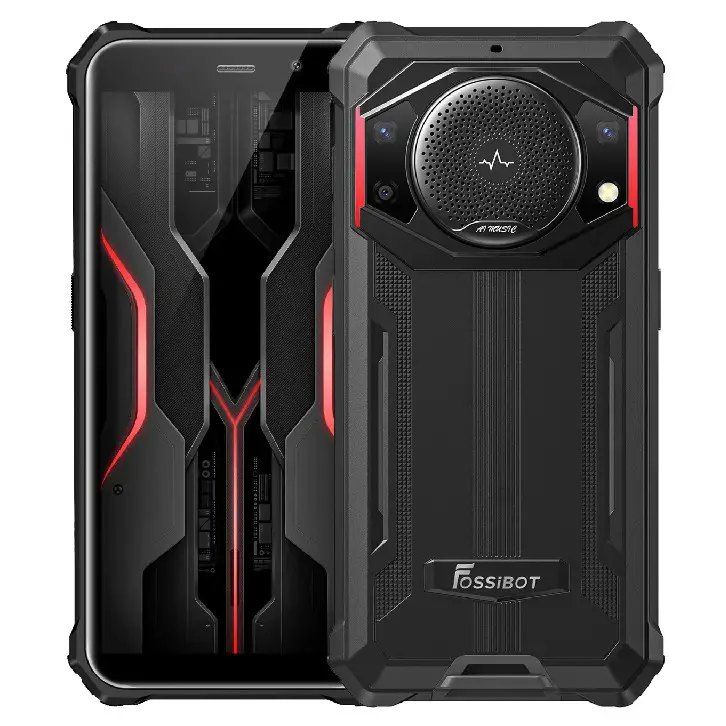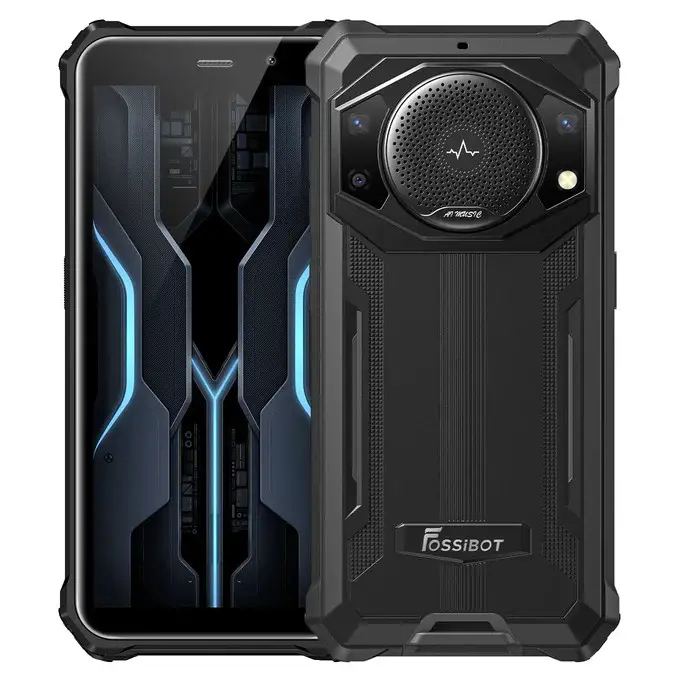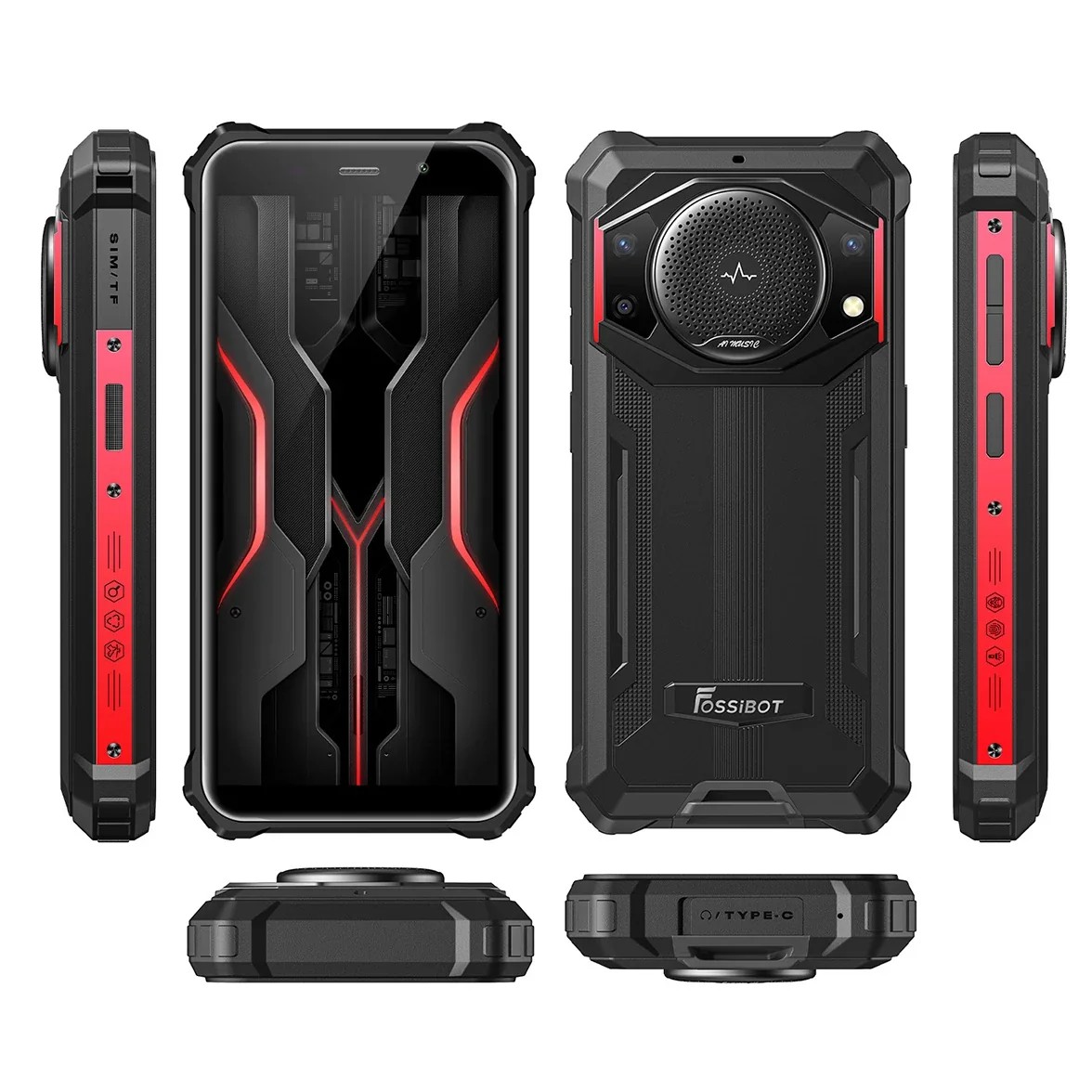



The Fossibot F101P is a rugged smartphone designed for those who need a durable phone that can withstand the elements. The device was announced in March 2023 and boasts an IP68/IP69K dust and water resistance rating, along with MIL-STD-810H certification for drop protection. This means the phone can survive being submerged in water, dusty environments, and drops onto concrete.
The F101P features a 5.45-inch TFT LCD touchscreen display with a resolution of 720 x 1440 pixels. The display is protected by scratch resistant glass, but the material of the glass is not specified. Also, it should not be confused with the F101 Pro which have dual screen configuration.
Under the hood, the F101P is powered by a MediaTek MT8768V Helio P22 chipset with an octa-core 2.0GHz Cortex-A53 CPU and IMG PowerVR GE8320 GPU. It comes with 4GB of RAM and 64GB of storage. The RAM can be virtually expanded by up to 3GB using software, and the storage can be further expanded with a microSD card up to 128GB, but this will take up the space for the second SIM card.
The camera system on the F101P consists of a triple-lens rear setup with a 24MP main sensor, a 5MP ultrawide sensor, and a 0.3MP depth sensor. The front-facing camera for selfies is 8MP and lacks a LED flash. The rear camera can record videos in 1080p resolution at 30fps.
For connectivity, the F101P supports Bluetooth 5.0, WiFi 2.4G-5G, FM radio, and USB Type-C. Navigation is aided by A-GPS, GLONASS, BeiDou, and Galileo. The phone also has a fingerprint scanner on the side, an accelerometer, and a proximity sensor.
The F101P packs a large 10,600mAh battery that is not removable. It supports 18W fast charging for quickly replenishing the battery. The phone comes in black and red color options. One interesting feature is the 123db 3W loud speaker, which is also HAC (Hearing Aid Compatibility) certified.
| Launch This refers to the date when this device was officially introduced into the market. | Announced 2023, March 19 / Released 2023, March |
| Brand / Model These are key identifiers that indicate the manufacturer or company that produces this smartphone, and the specific model of the phone. | Fossibot / F101P |
| 2G Bands 2G refers to the second generation of cellular technology and includes various frequency bands for basic voice and text communication. | GSM Band 850 / 900 / 1800 / 1900 - SIM 1 and SIM 2 |
| 3G Bands 3G refers to the third generation of cellular technology, encompassing different frequency ranges for faster data speeds, mobile internet, and multimedia capabilities. |
3G Bands 1 / 2 / 4 / 5 / 8 1 / 8 - Eurasian Countries |
| 4G Bands 4G refers to the fourth generation of cellular technology, operating in specific frequency bands to provide significantly faster data speeds, supporting high-definition video streaming and advanced applications. |
LTE Bands 1 / 2 / 3 / 4 / 5 / 7 / 8 / 12 / 17 / 18 / 19 / 20 / 25 / 26 / 28A / 28B / 38 / 39 / 40 / 41 / 66 1 / 3 / 7 / 8 / 19 / 20 / 38 / 40 / 41 - Eurasian Countries |
| Ruggedity This indicates the device's durability and ability to withstand harsh conditions or impacts. It is a very popular term used with tough or rugged phones. IP68/IP69K are international ratings that measure a smartphone's resistance to dust and water. MIL-STD-810H is a military standard that sets criteria for the environmental and durability testing of electronic devices. It means this device has undergone various tests to demonstrate its resilience in challenging conditions, such as extreme temperatures, humidity, vibration, and shock. |
IP68 / IP69K / MIL-STD-810H - Water / dust resistant / drop-to-concrete resistance |
| Dimensions / Weight: This refers to the physical size and weight of the device, measured in millimeter (mm) and grams (g) respectively. | 155.7 x 76.2 x 20.35 mm / 350 grams |
| SIM SIM stands for "Subscriber Identity Module." It is a small card, typically inserted into a slot in a mobile phone, that contains important information for connecting the device to a mobile network. SIM cards can come in various sizes, including standard SIM, micro SIM, nano SIM, or even electronic (eSIM), depending on the phone's design. | Hybrid Dual SIM (Nano-SIM, dual stand-by) |
| Screen Display refers to the screen or visual interface of the device. It includes details such as screen size, resolution, and technology (e.g., LCD, OLED, AMOLED). | 5.45-inches / IPS LCD touch screen / 16M colors |
| Resolution Screen Resolution refers to the number of pixels that make up the display screen and is typically expressed as a combination of horizontal and vertical pixel counts (e.g., 1920 x 1080, 2560 x 1440, or 3840 x 2160). The screen resolution determines the level of detail and sharpness of the visual content displayed on the smartphone's screen. Higher resolutions generally result in crisper and more detailed images and text | 720 x 1440 pixels / 18:9 aspect ratio / 295 PPI |
| Features Camera features encompass various functionalities and capabilities that enhance the device's photography and videography experience. These features can include Optical Image Stabilization (OIS) Panorama, HDR, Ai Mode, Night Mode, Portrait Mode, etc. | Scratch resistant glass (unknown) |
| OS This is the Operating System. It refers to the software platform that runs on the smartphone and manages the device's hardware and software resources. Common smartphone operating systems include Android (developed by Google), iOS (developed by Apple). | Google Android 13 |
| Chipset This refers to the integrated circuit that serves as the device's central processing unit (CPU). It plays a pivotal role in the smartphone's performance, speed, and energy efficiency. |
MediaTek MT8768V Helio P22 - Octa-core 2.0GHz Cortex-A53 - IMG PowerVR GE8320 GPU |
| Memory This encompasses two components: storage capacity and RAM (Random Access Memory). Storage capacity, typically measured in gigabytes (GB) or terabytes (TB), dictates how much internal space is available for apps, files, and media storage. RAM, measured in gigabytes (GB), is temporary memory crucial for multitasking and app performance, with more RAM generally leading to smoother operation and faster task-switching capabilities. |
4GB RAM + 64GB ROM - Expandable RAM: 3GB - SD-card support up to 128GB (uses SIM 2 slot) |
| Main The main camera, also known as the rear camera, is the primary camera on the back of the smartphone. It is typically used for capturing photos and videos in various scenarios and is often the more powerful and versatile camera on the device |
Main: 24MP, PDAF, F/2.2 Ultrawide: 5MP, 82° FoV Depth: 0.3MP |
| Selfie The selfie camera, also known as the front-facing camera, is the camera on the front of the smartphone, primarily used for capturing selfies and video calls | 8MP selfie camera (fixed focus), No LED flash |
| Features Camera features encompass various functionalities and capabilities that enhance the device's photography and videography experience. These features can include Optical Image Stabilization (OIS) Panorama, HDR, Ai Mode, Night Mode, Portrait Mode, etc. | 1080p@30fps video recording / LED Flash |
| Connectivity This encompasses the device's ability to connect and communicate with other devices and networks. It includes features such as cellular connectivity, Wi-Fi, Bluetooth, NFC (Near Field Communication), and USB connectivity options. | Bluetooth 5.0 A2DP / WiFi 2.4G-5G / FM Radio / USB Type-C |
| Navigation Navigation refers to the device's ability to determine and display location information and provide directions to users. This functionality is usually powered by Global Positioning System (GPS) technology. | A-GPS, GLONASS, BeiDou, Galileo |
| Sensors This refers to the various built-in sensors that enable the device to gather information from its environment and interactions. Common sensors found in rugged smartphones may include fingerprint sensor, light sensor, barometer sensor among others. | Fingerprint scanner (side), accelerometer, proximity |
| Battery This section refers to the device's power source and its related specifications. This typically includes details such as the battery capacity, measured in milliampere-hours (mAh) or watt-hours (Wh), and it charging details. | Li-Po 10,600mAh, non-removable with 18W fast charger |
| Others This is a catch-all category that includes various additional features, specifications, or capabilities that don't fall under the major categories like display, camera, memory, or connectivity. |
Black and Red colors HAC 123db 3W loud speaker |
These specifications were entered manually, hence we CANNOT guarantee 100% accuracy. Also, that your device is listed on this website DOES NOT call for reckless usage! It is crucial to exercise due diligence, as we cannot be held responsible for any damage to your device due to overconfidence in it built quality.
Leave a Reply